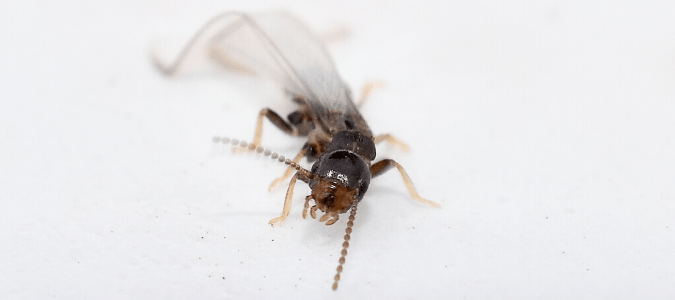
If you have spotted a swarm of small insects flying or crawling inside your home or elsewhere on your property, you might have instantly feared a pest infestation—and then asked yourself, “Do termites have wings?” The short answer here is yes: Certain types of termites in certain stages of their life cycle do have wings.
Not all termites have wings, however, and even those that do have wings don’t keep them forever. Furthermore, there are other winged insects, such as winged ants, that are commonly and easily mistaken for termites. A professional exterminator can determine exactly what type of insect is swarming in or around your home, whether it’s a termite, a winged ant or something else altogether. There are also certain signs and characteristics that homeowners can learn to look out for in order to make an initial diagnosis on their own.
Wanting to know how to identify termites and distinguish them from other insects, with or without wings, is understandable. Concern over termites is certainly not unfounded. Subterranean termites, which are the most common type of termite in the United States, cause billions of dollars’ worth of damage every year to American homes and other structures. These insects are silent destroyers: They work quietly, in the darkness of interior walls and crawl spaces, tunneling into wood and consuming its cellulose—the organic compound within wood that gives it strength, stiffness and form—until its internal structure is weakened to the point of needing extensive repair or complete replacement.
This is why it’s important to know how to identify termites, especially since not all termites have wings. There are three different types of termites within a colony, collectively referred to as castes, and only one of the castes—the reproductives—have wings. Also called alate nymphs, reproductive termites are the termites that swarm out of the colony during swarming season (typically spring or summer, and often after a warm rain) in order to form new colonies and reproduce.
When swarmers leave the colony, they head toward the first light they see, which is why people often spot these insects around windows, doors and light fixtures. These termites, as pictured above, are dark-brown or black in color and measure about a quarter-inch to a half-inch long. They have two pairs of wings, mounted closely together just below the head at the top of the thorax, that are even in length. Their wings are long, often about twice the length of their bodies, which can make swarmers appear to be even longer than they really are.
Swarmer termites don’t keep their wings forever. These reproductives shed them once they’ve left their colony of origin and found a new mate and location to reproduce. This is why piles of tiny wings are another common sign of a termite infestation. These wing piles are often found on windowsills, near exterior doors and in other places located near a light source, since reproductive termites leave their dark colonies and head for the light.
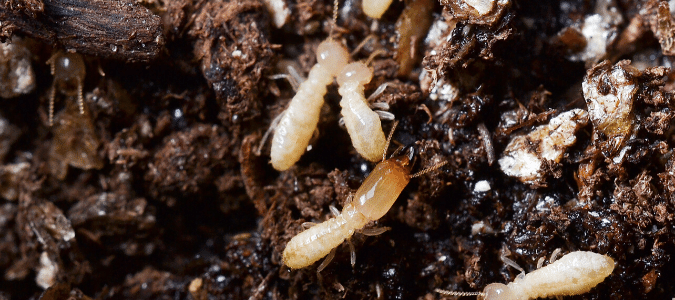
Worker and soldier termites, pictured above, do not have wings. These types of termites are actually quite distinct in appearance from reproductive termites. Soldier termites are the defenders of the colony. Smaller than reproductives, they are pale brown and have a powerful pair of pincers for defending their nest from ants and other potential threats. Worker termites are the smallest and palest version of the three termite castes. They are typically very pale brown or almost white in color, and translucent, and are even smaller than soldiers. Workers are the termites that perform most of the labor within the colony, such as building the nest, constructing tunnels and caring for the young.
Most homeowners will never see soldier or worker termites, since these termite castes live out their entire lives within their colonies and inside the walls or other spaces where they consume the wood that frames a structure. Winged reproductives are the only termites that venture out of the colonies into open spaces, where they can easily be seen. Pest control specialists do see all three types of termites, since they know where to look for termite colonies and how to uncover even hidden insects within walls or other areas around the home.
Due to the extremely destructive nature of termites, homeowners often have many questions about these pests, including how to identify a termite nest, if these pests are blind and how to determine if your hardwood floors have damage. We’ll answer all of these questions for you. But, to start, you’ll want to make sure what’s in your home is, in fact, termites and not something else.
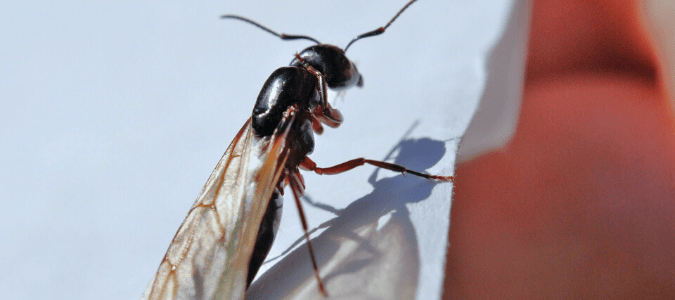
Ant Swarmers Vs. Termite Swarmers
You might have heard of ant swarmers and wondered how these differ from winged termites. To determine whether you have swarming ants, pictured above, or swarming termites, you must first learn the differences between these two insects. There are several ways to tell ant swarmers and termite swarmers apart, but these differences are subtle.
First, winged termites have bodies that are more uniform in width from their heads to the ends of their abdomens. Put another way, termites have thick waists, while ants have thin, pronounced waists. Winged termites and ants also have differences in their wings: Termites have two pairs of wings that are the same length as each other, while winged ants have one larger pair of wings and one smaller one. Finally, winged ants have bent antennae, whereas winged termites’ antennae are straight.
Both of these insects typically swarm in the spring and early summer, when temperatures warm up and there is plenty of wet weather. Subterranean termites need plenty of moisture to survive, as opposed to drywood termites, which are less common than their subterranean cousins. Drywood termites are typically found in attic beams and other high-up locations rather than in colonies located closer to or underneath the ground, which is where subterranean termites build their nests.
Spotting a winged insect, or a swarm of them, can raise real questions for homeowners about whether they have an insect infestation, and if so, exactly what type of insect it might be. This is why it’s important to know the signs of a termite infestation. The most common sign of a termite infestation that homeowners see is swarms of winged termites around doors, windows or light fixtures in the spring, which is prime swarming season, or small piles of tiny wings in the same areas—evidence that reproductives recently swarmed and then shed their wings before heading off to found new colonies.
Another common sign of a termite infestation is tubes of mud on the foundation or exterior walls of the home or garage. Subterranean termites build these tubes to use as pathways between their colonies and their primary food and water sources. These passageways serve as protection from the sun and from potential predators. Termite droppings, which look like tiny bits of wood or sawdust, are another common sign of an infestation; chipped paint, hollow-sounding wood (when knocked upon) and a faint, fast, rhythmic tapping noise coming from within the walls or wooden decking can also point to the presence of termites.
Now that we have described what different types of termites and winged ants look like, let’s go into more detail about termite nests.
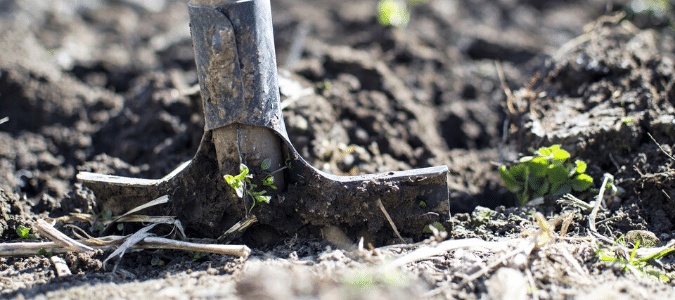
What Does A Termite Nest Look Like?
Subterranean termite nests are usually located underground, in damp soil near homes, garages, fences and other wooden structures. This makes it difficult for the average homeowner to find a termite colony, especially as the colony becomes established and grows, branching out via tunnels and mud tubes to accommodate the thousands or even millions of termites that are living and feeding together.
Drywood termite nests can usually be found in the eaves or ceiling beams of attics or garages. These termites are somewhat less common than subterranean termites, and their colonies are typically smaller, numbering in the hundreds or thousands instead of the thousands or even millions. They don’t need as much moisture as subterranean termites to survive, hence their name—they can thrive on dry wood that contains very little moisture.
If you do uncover a termite nest, you’ll probably see members of the whitish, wingless termite caste—the workers—rather than the darker, winged reproductive caste that people are more commonly familiar with. You might also spot little white termite eggs. The nest itself will be made of tunnels and hollow spots within dirt, mud and decomposing wood. If you discover something that you think might be a termite nest, the best course of action is to call in a licensed and trained pest control specialist to determine whether you have termites, ants or something else, and then determine the best remedy for the situation.
Are Termites Blind?
This question comes up because termites nest, breed, move around and feed in the darkness—and it’s true that two of the three termite castes are typically blind. Worker termites and soldier termites don’t have eyes, and they live out their lives within the colony or traveling along the mud tubes that provide protected passage between their nest and their primary food and water source. Thus, they don’t need eyes to see.
Reproductive termites, on the other hand, do have eyes and therefore are not blind. Their eyesight isn’t very strong, however, which is why, when they swarm out of the nest during swarming season in order to reproduce and found new colonies, they head straight for the first light they see.
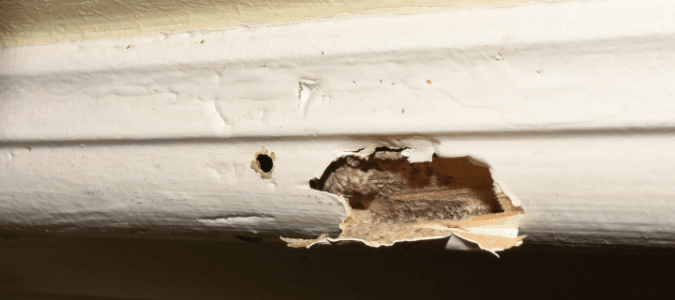
Termite Damage: Wood Floor Boards And Other Wooden Areas Of The Home
If you’ve noticed tiny hollow tunnels in your flooring or baseboards, there is a strong chance that what you’re seeing is termite damage to wood floor boards. Other signs of termite damage in wood floor boards, furniture legs and other wooden areas of your home include an unusually hollow sound when knocking against the wood, or even a fast rattling or tapping sound that seems to happen in response to your knocking. This sound could be termites knocking their heads against wood or mud tubes—an instinctive behavior they perform when they feel threatened.
If you suspect there is termite damage in wood floor boards or other wooden areas of your home, it’s time to call in a professional exterminator to determine whether termites are present and what the best course of action might be to remedy the situation before further damage occurs.
ABC Can Protect Your Biggest Investment From Termites
Termites are capable of causing extensive damage to a home. If you suspect you have termites nesting on your property, your best course of action is to call in the highly-trained specialists at ABC Home & Commercial Services. After we implement effective measures to eradicate the entire colony, you can sign up for our ongoing monitoring services so that we can catch signs of termite activity before a full-blown infestation takes place.
